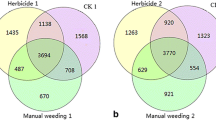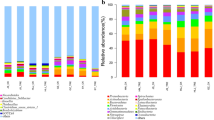Abstract
Sewage is widely used on agricultural soils in peri-urban areas of developing countries to meet shortages of water resource. Although sewage is a good source of plant nutrients, it also increases the heavy metals loads to soils. Microbial responses to these contaminants may serve as early warning indicators of adverse effects of sewage irrigation on soil quality. The purpose of this study was to assess the effect of time of sewage irrigation on soil microbial indicators. Soil samples were collected from seven soil sites (S1–S7) irrigated with 0 years, 16 years, 23 years, 25 years, 27 years, 32 years and 52 years, respectively in Shijiazhuang of China and analyzed. For each soil sample, we determined the quantities of bacteria, fungi and actinomycete, and enzyme activities of urease, sucrase, phosphatase, dehydrogenase and catalase. Our results showed that the soils of S2–S7 irrigated with sewage effluents for different times (ranged between 16 and 52 years) exhibited higher densities of bacteria, actinomycete, urease, sucrase and phosphatase but lower densities of fungi when compared with S1 irrigated with sewage effluents for 0 years. The soil S7 irrigated with sewage effluents for longest times (52 years) contained lowest activities of catalase when compared with the soils of S1–S6. The densities of bacteria (R = 0.877, p < 0.01), actinomycete (R = 0.875, p < 0.01), sucrase (R = 0.858, p < 0.01) and phosphatase (R = 0.804, p < 0.05) were significantly correlated in a positive manner with time of sewage irrigation. Soil fungi quantities and urease, dehydrogenase and catalase activities did not change significantly with irrigation time. This study confirms that sewage irrigation had negative effects on microbial properties including fungi, catalase and dehydrogenase in the long term, so there is a need for continuous monitoring for sustainable soil health.

Similar content being viewed by others
References
Adesemoye AO, Opere BO, Makinde SCO (2006) Microbial content of abattoir wastewater and its contaminated soil in Lagos, Nigeria. Afr J Biotechnol 5:1963–1968
Babayan M, Javaheri M, Tavassoli A, Esmaeilian Y (2012) Effects of using wastewater in agricultural production. Afr J Microbiol Res 6(1):1–6
Bao SD (2000) Soil agro-chemical analysis, 3rd edn. China Agricultural, Beijing (in Chinese)
Bhattacharyya P, Tripathy S, Chakrabarti K, Chakrabati A, Banik P (2008) Fractionation and bioavailability of metals and their impacts on microbial properties in sewage irrigated soil. Chemosphere 72:543–550
Cao J, Jia HL, Xu HY, Lu Y, Su ZZ, Zhang QF (2008) Relationships between soil enzymatic activities and Cu-Ni compounds pollution in the wastewater irrigated farmland in arid region. J Agro-environ Sci 27(5):1809–1814 (in Chinese)
Chen JY, Tang CY, Yu JJ (2006) Use of 18O, 2H, and 15N to identify nitrate contamination of groundwater in a wastewater irrigated field near the city of Shijiazhuang China. J Hydrol 326(1–4):367–378
Dakoure MYS, Mermoud A, Yacouba H, Boivin P (2013) Impacts of irrigation with industrial treated wastewater on soil properties. Geoderma 200:31–39
Deshmukh SK, Singh AK, Datta SP, Annapurna K (2011) Impact of long-term wastewater application on microbiological properties of vadose zone. Environ Monit Assess 175:601–612
Fonseca AF, Herpin U, Paula AM, Victoria RL, Melfi AJ (2007) Agricultural use of treated sewage effluents: agronomic and environmental implications and perspectives for Brazil. Sci Agricola 64(2):194–209
Guan SY (1986) Soil enzyme and its research methods. Agricultural, Beijing (in Chinese)
Hamilton AJ, Stagnitti F, Xiong XZ, Kreidl SL, Benke KK, Maher P (2007) Wastewater irrigation: the state of play. Vadose Zone J 6(4):823–840
Karpouzas DG, Ntougias S, Iskidou E, Rousidou C, Papadopoulou KK, Zervakis GI, Ehaliotis C (2010) Olive mill wastewater affects the structure of soil bacterial communities. Appl Soil Ecol 45(2):101–111
Lu RK (2000) Chemical analysis methods of agricultural soil. China Agricultural Science and Technology, Beijing (in Chinese)
Lucho-Constantino CA, Alvarez-Suarez M, Beltran-Hernandez RI, Prieto-Garcia F, Poggi-Varaldo HM (2005a) A multivariate analysis of the accumulation and fractionation of major and trace elements in agricultural soils in Hidalgo State, Mexico irrigated with raw wastewater. Environ Int 31(3):313–323
Lucho-Constantino CA, Prieto-Garcia F, del Razo LM, Rodriguez-Vazquez R, Poggi-Varaldo HM (2005b) Chemical fractionation of boron and heavy metals in soils irrigated with wastewater in central Mexico. Agric Ecosyst Environ 108(1):57–71
Meli S, Potro M, Belligno A, Belligno A, Bufo AS, Mazzatura A, Scopa A (2002) Influence of irrigation with lagooned urban wastewater on chemical and microbiological soil parameters in a citrus orchard under Mediterranean condition. Sci Total Environ 285:69–77
Murtaza G, Ghafoor A, Qadir M, Owens G, Aziz MA, Zia MH, Saifullah (2010) Disposal and use of sewage on agricultural lands in Pakistan: a review. Pedosphere 20(1):23–34
Ndour NYB, Baudoin E, Guisse A, Seck M, Khouma M, Brauman A (2008) Impact of irrigation water quality on soil nitrifying and total bacterial communities. Biol Fertil Soils 44(5):797–803
Ramirez-Fuentes E, Lucho-Constantino C, Escamilla-Silva E, Dendooven L (2002) Characteristics, and carbon and nitrogen dynamics in soil irrigated with wastewater for different lengths of time. Bioresour Technol 85(2):179–187
Speir TW (2002) Soil biochemical properties as indices of performance and sustainability of effluent irrigation systems in New Zealand—a review. J R Soc New Zealand 32(4):535–553
State Bureau of Environmental Protection (2002) Water and wastewater monitoring analysis method, 4th edn. China Environmental Science, Beijing (in Chinese)
Tessier A, Campbell PGC, Bisson M (1979) Sequential extraction procedure for the speciation of particulate trace metals. Anal Chem 51:844–851
The Chinese academy of sciences in institute of soil microbial room (1985) Soil microbial research methods. Science Press, Beijing (in Chinese)
Wang GL, Lin WJ (2003) Contamination of soil from sewage irrigation and its remediation. J Agro-environ Sci 22(2):163–166 (in Chinese)
Zhang J, Zhang WH, Zhang CG (2010) Effect of groundwater irrigation on soil PAHs pollution abatement and soil microbial characteristics: a case study in northeast China. Pedosphere 20(5):557–567
Acknowledgments
This study is financially supported by National Program on Key Basic Research Project of China (973 Program) (No. 2010CB428802), National Natural Science Foundation of China (No. 40872157, No. 41372252), Research Fund for the Doctoral Program of Higher Education (No.20110145110003), National High Technology Research and Development Program of China (863 Program) (2012AA062602), Program for New Century Excellent Talents in University of Ministry of Education of China (No. NCET-07-0773), the Fundamental Research Funds for the Central Universities (No. CUGL100501) and the Critical Patented Projects in the Control and Management of the National Polluted Water Bodies (2012ZX07204-003-04).
Conflict of interest
The authors declare that they have no conflict of interest.
Author information
Authors and Affiliations
Corresponding author
Rights and permissions
About this article
Cite this article
Guo, X., Ma, T., Chen, L. et al. Microbial quantities and enzyme activity in soil irrigated with sewage for different lengths of time. Ecotoxicology 23, 2062–2068 (2014). https://doi.org/10.1007/s10646-014-1319-2
Accepted:
Published:
Issue Date:
DOI: https://doi.org/10.1007/s10646-014-1319-2




